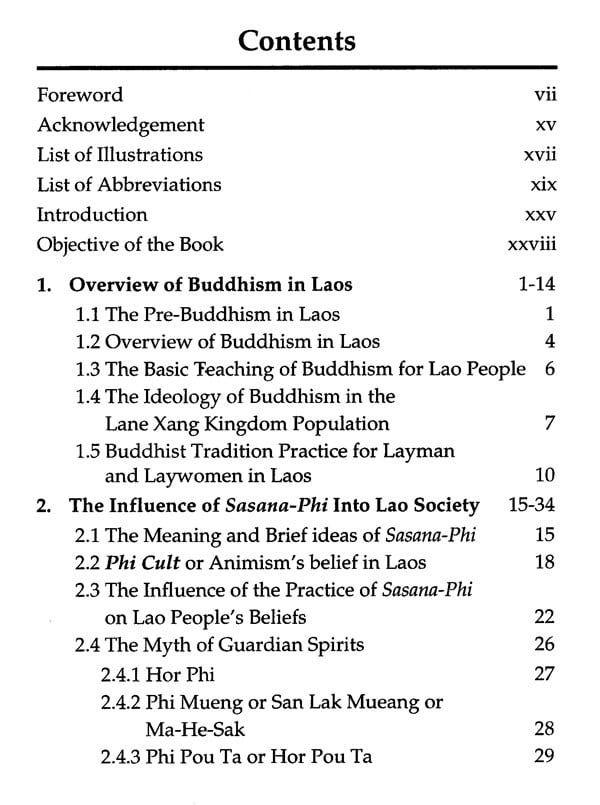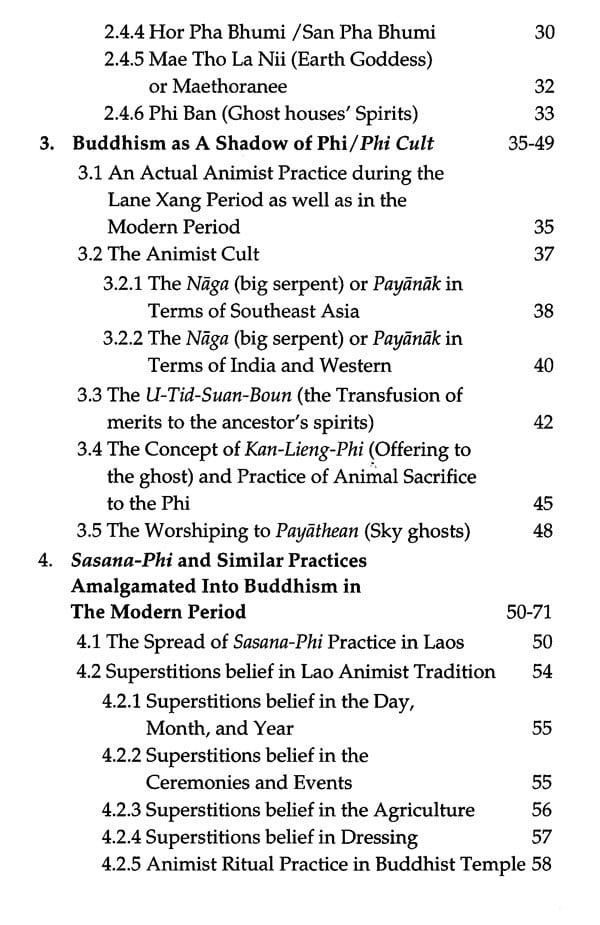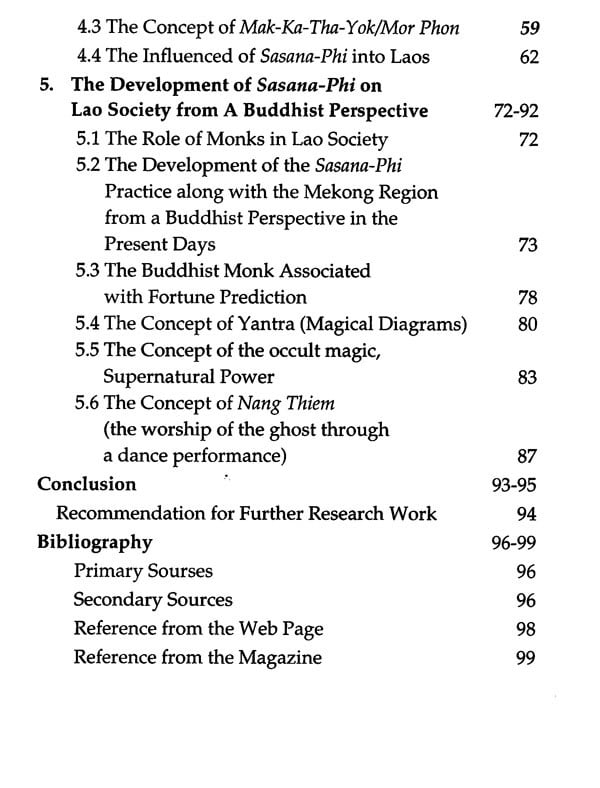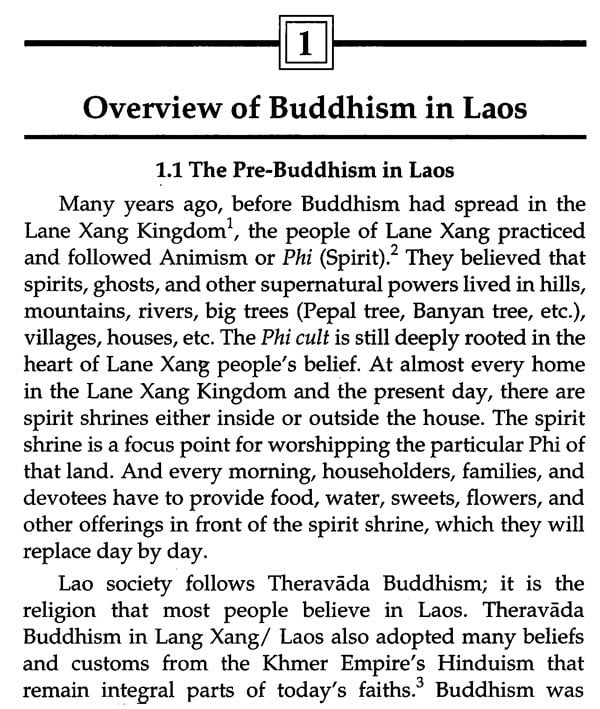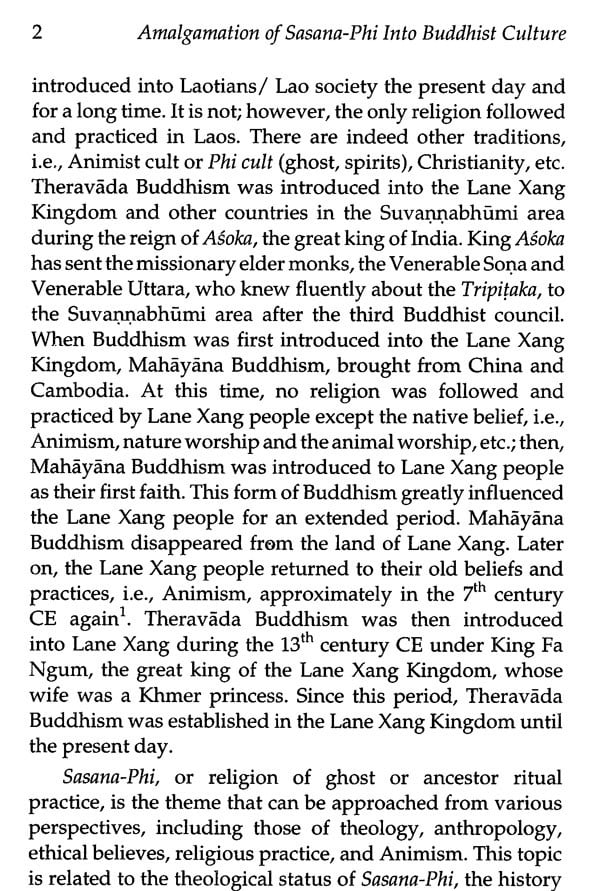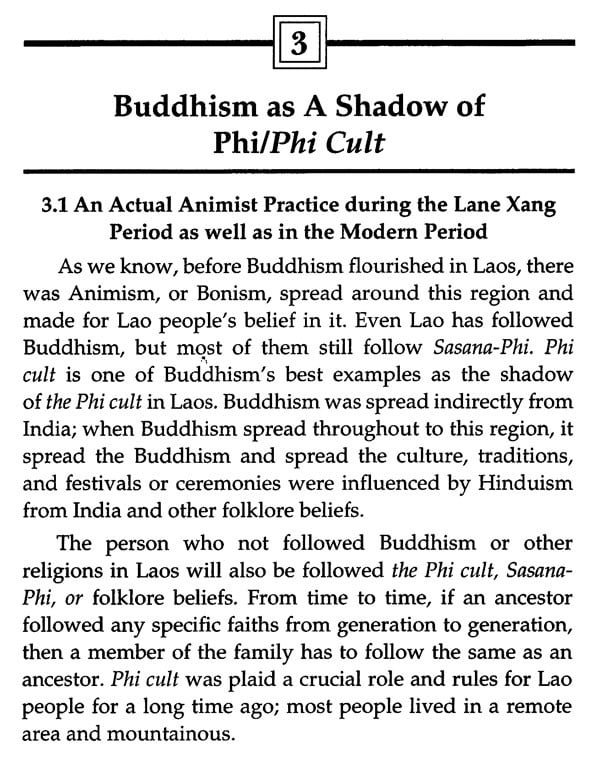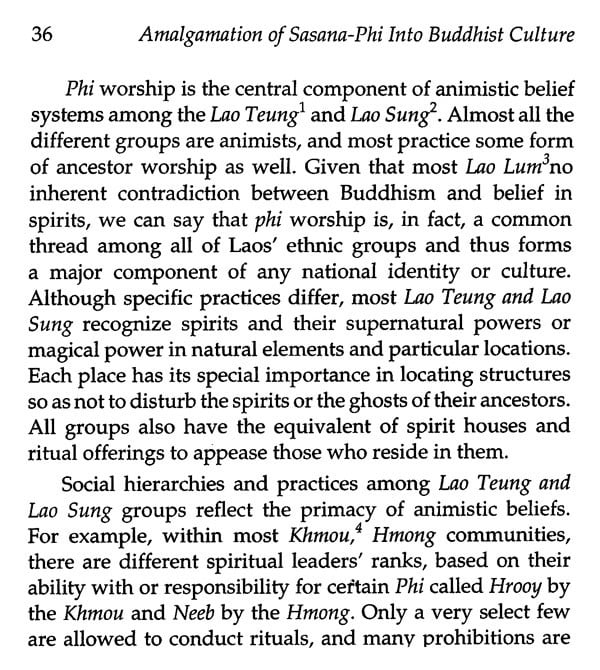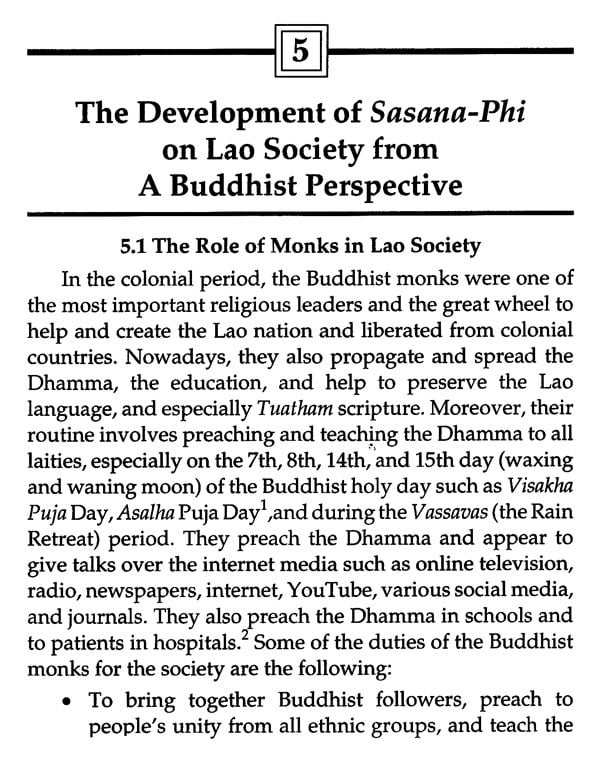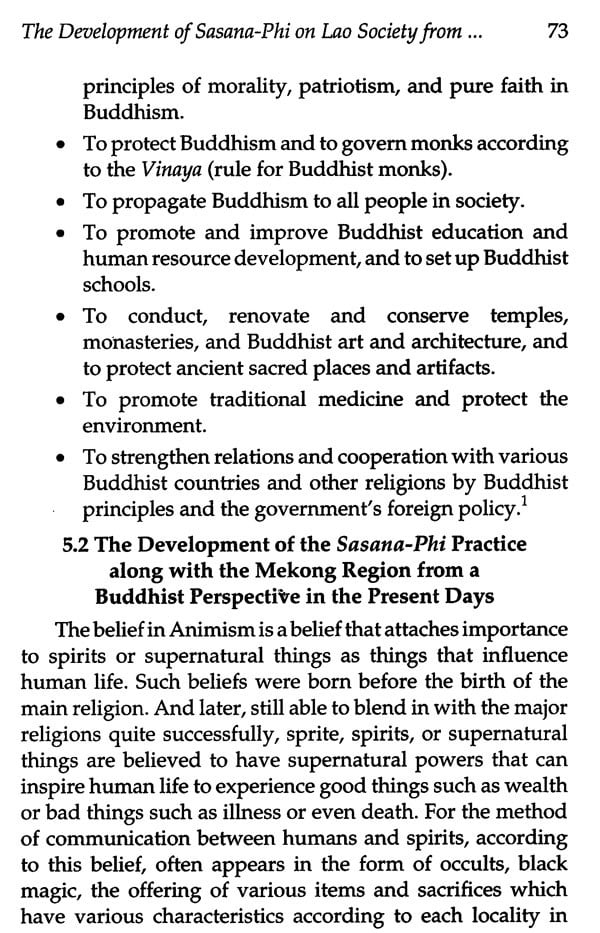
Amalgamation of Sasana - Phi Into Buddhist Culture of Lao (A Study of Its Impact and Significance)
Book Specification
| Item Code: | NBZ988 |
| Author: | Ven. Laungsalath Khonsavanh |
| Publisher: | Eastern Book Linkers |
| Language: | English |
| Edition: | 2021 |
| ISBN: | 9788178543871 |
| Pages: | 123 |
| Cover: | HARDCOVER |
| Other Details | 9.00 X 6.00 inches |
| Weight | 330 gm |
Book Description
"Amalgamation of Sasana-Phi into Buddhist Culture of Lao: A Study of its Impact And Significance," is focused on the Amalgamation of Sasana-Phi on Buddhism in Lao cultures, traditions, and festivals even in every aspect of the Buddhist monks and lay devotees' ritual practice from the ancestral time to the present day. Along with this, I will briefly explain the overview of Pre-Buddhism at the time of the Lane Xang Kingdom, how Buddhism spread to the land of Lane Xang Kingdom and what was the basic teaching of Buddha. This book also aims to explore the introduction of Buddhist ideology on the Lao population, which comes from an earlier time. Moreover, I also mentioned various points of view about the concept of ghost ancestor ritual practice, the way of practice of ghost ancestor ritual, and the myth of Guardian spirits like the concept of Naga/ Payanak (big serpent). Moreover, the critical highlight ritual concepts practice of Sassana-Phi such as the Lao New Year Festival, the Baci ceremony, the concept of the U-Tid-SuanBoun (transfusion of merits to the ancestor's spirits), the concept of Kan-Lieng-Phi (Offering to the ghost) along with the practice of worshipping the ghosts, the Nang Thiem (the worship of the ghost through dance performance), the practice of animal sacrifice to the spirits and other festivals which related to the Sasana-Phi ritual concepts practice. And the last, I will discuss the combination of Sasana-Phi and Buddhism practice and the other religions existing in Laos.
'Ven. LUANGSALATH KHONSAVANH was born in 1991 at Salakham village, Hatzayfong District, Vientiane Capital, Lao PDR. Ven. KHONSAVANH was entered into the Sangha community as a Samanera under the guide of Ven. Viengkeo THIEKKAVARO in 2003. After two years, he could complete the proper way of Samanera, then he shifted to Ngew-Ngo temple and adopted the Master, Ven. Lay SOULAPANNO (PHONGSA) until he has completed the Banhom Buddhist Lower Secondary school in 2006, and Sokphaluang Buddhist High School, Vientiane Capital in 2009. In 2009 he had joined the Ong Tue Sangha college, Vientiane Capital, Laos. He has completed the Master's Degree (M.A) in Buddhist Studies, Philosophy, and Comparative Religions under the CLMV Scholarship from the Department of Buddhist Studies at Nalanda University, Rajgir, in 2018. Moreover, he has pursued the higher education level in India and completed M. Phil from the Department of Buddhist Studies & Civilization from the Gautam Buddha University in 2020. He has participated and presents his research work on many aspects of Buddhism at the national and international conferences, even in India, Thailand, and Lao PDR. During his studies B.A and M.A in 2012- 2018, he was a committee member of Wat Lao Bodhgaya, Gaya, India. He became the guided tour of the main and sub-sacred Buddhist circuits (Bodhgaya, Sarnath, Kusinara, and Lumbini, etc.) for the Lao, Thai pilgrims around India and Nepal.
In South and Southeast Asia, Buddhism developed in the midst of local religious worship that was peopled by beings called devatas, occupying a space somewhere between humans and gods. This resulted in a rich synchronism between Buddhist practice and the ritual, mythic, and artistic life of spirit believers. When Buddhism moved into Southeast Asia, it came not only with Indian notions of karma and rebirth, but also with these devata worlds that, in their Indian forms, seeped into settings like Burmese, Thai, Lao, and Khmer such that their local names reflected their Sanskritic origins, and their configurations expressed their Indian counterparts. In contemporary Southeast Asian communities, monks and laypeople recognize terms such as kinnaras, gandharvas, apsaras, and nagas, and are able to identify them among the stone and gilded reliefs, the painted images, and the brilliant sculptures of Buddhist temple grounds. The experience of these devatas for local populations today is a visceral and immediate one, and for many in Southeast Asia, as in South Asia, the world is filled with spirit beings that are alive, active, and intimately involved in human lives. While the Sanskrit and Pali word for these beings is devata, two translations cover different aspects: "semi-divine," or intermediate, focuses on their place in the cosmos, and "spirit deity" focuses on their interaction with human activity. The term devata is found throughout South and Southeast Asia, while nat is used in Burma and phii (or pii) in countries like Thailand and Laos. These semi-divines inhabit levels of the cosmos, underworld, earth, atmosphere, and heavens, among which they move easily. They marry with humans, are emissaries between worlds, and are guardian powers of the human body, of human spaces, and of material objects like treasures or jewels. However, spirit deities require rituals of honor and appreciation to remain beneficial for humans, and rituals of reconciliation to avoid feeling offended. Devatas often have dwelling places in nature, a tree, a river bend, or a stone, and their power is held in amulets like clothing or jewelry to assure well-being. From the beginning, local practice of Buddhism accommodated to the worship of the spirit beings, and this facilitated its spread across Asia. There are many lists of semi-divine beings in Hindu sources, and included here is a selection of those also found in Buddhist art, literature, and practice. While not all called devata, each group occupies the space between human and divine, and usually belongs to a specific cosmic arena.
The Buddhism practiced in Laos is of the Theravada tradition which is a unique version of Theravada Buddhism and is at the basis of the Lao Culture. Buddhism in Laos is often closely tied to animist beliefs and belief in ancestral spirits, particularly in rural areas, Theravada Buddhism is believed to have first reached Laos during the 7th- 8th Centuries CE, via the kingdom of Dvaravati. During the 7th Century, Tantric Buddhism was also introduced to Laos from the kingdom of Nan-chao, an ethnically Tai kingdom centered in modern day Yunnan, China. The Nan-chao kingdom also likely introduced the political ideology of the king as defender and protector of Buddhism, an important ideological tie between the monarchy and the Sangha in much of Southeast Asia. During the 11th-12th Century, Khmer rulers took control of Muang Sua, the historical region of the kingdom of Luang Prabang in northern Laos. During this period, Mahayana Buddhism replaced Theravada Buddhism as the dominant religious ideology of the ruling classes. Historically, the Lao state is regarded as beginning in 1353 CE with the coronation of Fa Ngum at Luang Prabang. Fa Ngum brought his Khmer Theravada teacher with him to act as adviser and head priest of the new kingdom. This Khmer monk named Phramaha Pasaman also brought to the kingdom a revered image of the Buddha that became known as the Phra Bang, the namesake of the city of Luang Prabang and the symbol of the Lao kingdom. Subsequent alliances with Myanmar and Thailand helped cement the primacy of Theravada Buddhism in the Laotian kingdom. Faced with rugged, isolating geography and the absence of a strong central government, Theravada Buddhism became one of the primary unifying features of Lao culture. Lao Buddhist is very devout and almost every Lao man joins a monastery, or temple, for at least a short period of time. Many men also become monks for the rest of their lives. Most people donate food to the monks to gain merit and improve their karma. The temples of Laos were once seen as "Universities" for monks. Lao Bhikkhus are highly respected and revered in Lao communities. Based on Laotian Buddhism, the women of Laos are taught that they can only attain Nibbana after they have been reborn as men. Lao history in fact begins in the 14th Century with a risque event, the seduction of one of the king's wives by his son Phi Fa, heir apparent to the throne.
From the very beginning, Laos seems to have been just barely strong enough to maintain a separate identity in the midst of its more powerful neighbours like the Thais, Burmese and finally the Vietnamese. As the Khmers too were finding out about this time, it was a question of being dominated by the related, Indianized cultures of Burma and Thailand or by the Vietnamese, who were especially hated because of their sacking of the Lao capital in 1479. Subservient alliances with Burma and Thailand were undesirable for Laos, but they had the effect of reinforcing Theravada Buddhism, which became the country's primary symbol of continuity and identity in the face of its shifting political fortunes. Because of the relatively weak central government of Laos, Theravada Buddhism became the primary cement holding together the numerous ethnic groups and inaccessible villages scattered through the mountainous countryside. According to the Lao model of kingship, the king sat upon the throne not so much because of divine right as because of his obviously good karma in his previous lives. He was expected to continue that good karma in this life by supporting the Sangha and promoting Buddhism through royal construction projects.
Many people in the world know that Buddhism was first established in India and later on disseminated abroad, particularly in the Asian continent. Therefore, Buddhism's background is closely related to Indian culture, religion, and society during the Buddha's lifetime, either at the end of the 6th century BC or the beginning of the 5th century BC. The Lao People's Democratic Republic (Laos) is one of the many countries which received Buddhism indirectly from India and later on becomes the main religion/ faith.
The Buddha changed the situation of Indian society and that of individuals around the world until today. He encouraged followers to proceed from the wrong to the right, from the bad to the good, and from the immorality to morality. The Buddha taught nonviolence, loving-kindness, compassion, happiness, peace, calm, and freedom from all pain and suffering to human beings. Therefore, after having attained enlightenment, he wandered to many places in India and outside such as Sri Lanka, Nepal, etc. and taught without any discrimination to poor and rich, white and black, business people, politician, leaders and labors, kings and serfs, or soldiers, low and high castes, etc.
This book titled: "Amalgamation of Sasana-Phi into Buddhist Culture of Lao: A Study of its Impact And Significance,' focuses on the Amalgamation of Sasana-Phi on Buddhism in Lao society from the pre-Buddhist as well as in the present day. Along with this, I will explain about the Buddhism in Lane Xang from the 13th century CE onward, under the reign of King Fa Ngum, the first great King the Lane Xang Kingdom. King Fa Ngum has changed the face of the Lane Xang Kingdom by strengthening the army. He also made Buddhism the primary faith for Lane Xang people and united all sub-lands into one Kingdom. Apart from this, I will relate this book to the other religions existing in Laos. Finally, I will discuss the combination of Sasana-Phi and Buddhism during the colonial period onward, and until Laos got independence from colonial rulers.
This book will be consisting of five chapters, excluding the Introduction and Conclusion, along with a bibliography. The structure of the book is as under:
Chapter I: The Overview of Pre-Buddhist in Lao
The first chapter, the overview of Pre-Buddhist in Laos, focuses on Pre-Buddhism in Laos from the 13th to the 19th century CE. This chapter deals with the overview of Buddhism at the time of the Lane Xang Kingdom, how Buddhism spread to the land of Lane Xang Kingdom, and the basic teaching of Buddha. It also aims to explore the introduction of Buddhist ideology to the Lao population from an earlier time.
Chapter II: The Influence of Sasana-Phi into Lao Society
The second chapter would deal with the Concept and meaning of Sasana-Phi (Religion of ghost ancestor ritual practice), its belief in Lao Culture. It will further deal with various views about the concept of ghost ancestor ritual practice, the way of practice of ghost ancestor ritual practice, and Lastly, I will discuss the myth of Guardian spirits.
Chapter III: Buddhism as a Shadow of Phi/Phi cult
In the third chapter titled "Buddhism as a shadow of Sasana-Phi/ Phi cult," I am going to explore with actual Animist practice during the Lane Xang period and the modern period's the combination and similarity between Animist practice and Buddhist practice. To give a clear idea on this practice, we will also highlight the concept of the U-Tid-Suan Boun (transfusion of merits to the ancestor's spirits), the concept of Naga/ Payanak (big serpent), the concept of Kan-Lieng-Phi (Offering to the ghost) along with the practice of worshipping the ghosts. Lastly, I will discuss the practice of animal sacrifice to the ghosts.
Chapter IV: Sassana-Phi and Similar Practice Amalgamated into Buddhism in the Modern Period
Here in this chapter, I would like to emphasize the spread of Sasana-Phi practice in Lao and its amalgamation with similar techniques that have been adopted in the Modern Lao Society. This chapter is going to through light on those practices which are similar to Sasana-Phi viz. Mak-Ka-Tha-Yok/Mor Phon (Ritual practitioner leader), the superstition belief, animist ritual practice in the Buddhist temple, etc. The Lao Buddhist monks also get associated with Sasana-Phi and its influence through the culture, tradition, and festivals that have been prevalent in the Modern Lao Society.
Chapter V: The Development of Sassana-Phi on Lao Society from a Buddhist Perspective
The fifth chapter, the Development and Significance of Sasana-Phi on Lao community from a Buddhist perspective, will try to investigate the development and significance of the Sasana-Phi practice in Laos Society from a Buddhist perspective in modern Lao Society in light of its conception of belief in future prediction, an association of Buddhist monks with Yantra, Mantra, supernatural power of stone (Dhatu), and occult magic including magic tattoo. Moreover, we will discuss the concept of Nang Thiem (the worship of the ghost through dance performance)
**Contents and Sample Pages**
